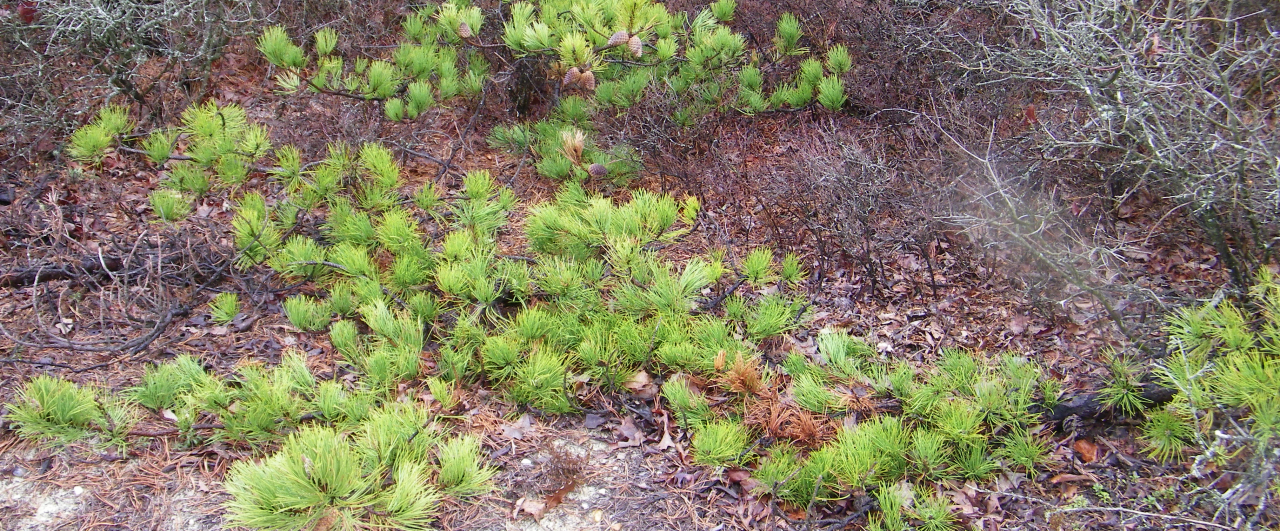Mark, John, any me met at Sunrise Highway and Route 31. John wanted to show us a section we knows about that he calls “the pure” dwarf pines. These are true dwarf trees. “This is the last stand of the pure trees. All the others areas have changed. With no fires, tall trees have grown within the dwarf pines.” John wanted to see this last stand before it too changes. “Without fire the dwarf forest will cease to exist.” This is one more example of how human species have changed the delicate balances of the natural world. I suspect that Long Island is the capitol of examples of damaged habitats
John brought a pair of loppers to clear overhanging branches. He is preparing to pay several visits to this area to photograph the beauty and strangeness of the dwarf pines.
We walked west parallel to Sunrise Highway straddling a fence on a sandy trail listening to traffic haul by. Huge amounts of litter have blown up against the fence. I started thinking about litter in a new way as a result of this hike. It almost represents non-native species that are invading native habitats. I looked at the litter and heard it say to me…”This is what you deserve. We are here for a reason. YOU. We defy you to do something and I can assure you, you can’t. It surely isn’t going to be another litter cleanup. We love the temporary vacuum from litter cleanups. We jump right back. Go ahead, pick up some litter. We love having a fresh empty space to fill back in.”

Dwarf Pitch Pine Tree growing close to the ground.
As we walked, I took pictures. We came across three deer skeletons. All three were from young deer. One of the skeletons had many broken bones. These were caused by fox who have strong jaws and favor bone marrow.
One skeleton was outside thfe fence leading to the conclusion that it was hit by a car and died at the fence. The other was half and half. Perhaps the head got stuck in the fence.
I found several plants that were just starting to flower; bear berry, pine barrens heather, blueberry, and sweet fern. Recent rain has darkened pitch pine trunks creating a strong contrast with the bottle brush needle structure of the pines.
The textures on the ground are interesting. I looked at the light gray globes of reindeer moss, dead browned grass clumps, waxy leaves of bear berry, small patches of green moss. There is no place else that I know of that has such fascinating ground cover.
“We have reached the pure dwarfs.” Said John. I could see the difference immediately. Many of the trees had branches right on the ground. The trees are severely stunted with very long lower branches that spread out over the ground. We also observed that the branches of one tree held up those of the one next to it. We had come in an amazing strange and beautiful forest.
I noticed something I’d never seen before. Where small branch tips touched the ground, the needles, moved by wind, brushed brown needles on the ground to create bare patches. The same thing happens at the seashore where wind blows beach grass which in turn etches a circular path around the stem. I looked carefully at deer toe prints. The two toes on softer sand were more spread out than on firmer soil. The cleft between the toes allows the toes to spread so as the deer walks it doesn’t get bogged down. Without the ability to have its toes spread, it would not be able to walk or run as fast.
We turned back and chose to turn left on another trail that we know knew would take us to the paved road. The pattern of our walk mimicked the letter ”T”. Along the path, I hear the calls of the rufus-sided Towhee, a ground loving bird that is right at home in its favorite thick, lush habitat. As we approached out cars, ah… back to the litter.

Leave a Reply